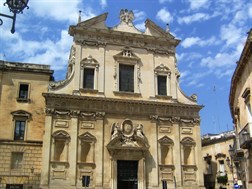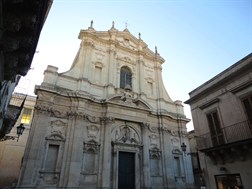Other glimpses of the Baroque in Lecce
The face of the Baroque in Lecce, dominated by works desired by its bishops and made by his most famous architects, is supplemented by other elements and details that help to reconstruct the face of the city in the sixteenth and seventeenth centuries.
The presence of Spanish power, which controlled the viceroyalty of Naples, which Lecce was part of, for over two hundred years, is testified to through the triumphal arch of Porta Napoli, built in 1548 in honour of Charles V, and the castle, built between 1539 and 1549, on the orders of the emperor. This structure, almost square in shape with bastions at the corners, has a chapel inside from the first half of the eighteenth century, with a Baroque altar.
 The presence of Religious Orders, which Bishop Pappacoda often confronted, is instead shown by the permanence of their churches and their homes. The Church of the Gesù, also known as that of the Madonna del Buon Consiglio (Our Lady of Good Counsel), was the site of the Company of Jesus for centuries. Built in 1575 on the site of an ancient church of the Greek-Orthodox rite, it was inspired by the model of the Church of the Gesù in Rome, and has a plain and linear façade, consisting of two orders. In the lower one, inside the broken tympanum above the portal, there is the emblem of the Society of Jesus adored by two angels. In the upper order, two side windows flank the central window surmounted by a niche with a statue of the Infant Jesus, while the sculpture of a PelicanIn heraldry, the Pelican is represented as it rips its breast to feed its young (Pelican in its pity), and as such is a symbol of pity, charity and love of neighbor. overlooks the top of the façade. Within there are the fresco of the Martyrdom of Saint Irene, the painting of the Circumcision of Jesus, the altar attributed to Giuseppe Cino and the altar dedicated to Saint Bernardino RealinoBernardino Realino (1530-1616) was born in Carpi, and after graduating in law and a brief political career, he entered the service of the viceroy of Sicily Franz Ferdinand d’Avalos. He moved to Naples where he entered the Society of Jesus, serving in Lecce, the city where he lived until his death. He was canonized by Pope Pius XII in 1947. His remains are preserved in the Church of Gesù, in the capital of Salento ., which houses his mortal remains.
The presence of Religious Orders, which Bishop Pappacoda often confronted, is instead shown by the permanence of their churches and their homes. The Church of the Gesù, also known as that of the Madonna del Buon Consiglio (Our Lady of Good Counsel), was the site of the Company of Jesus for centuries. Built in 1575 on the site of an ancient church of the Greek-Orthodox rite, it was inspired by the model of the Church of the Gesù in Rome, and has a plain and linear façade, consisting of two orders. In the lower one, inside the broken tympanum above the portal, there is the emblem of the Society of Jesus adored by two angels. In the upper order, two side windows flank the central window surmounted by a niche with a statue of the Infant Jesus, while the sculpture of a PelicanIn heraldry, the Pelican is represented as it rips its breast to feed its young (Pelican in its pity), and as such is a symbol of pity, charity and love of neighbor. overlooks the top of the façade. Within there are the fresco of the Martyrdom of Saint Irene, the painting of the Circumcision of Jesus, the altar attributed to Giuseppe Cino and the altar dedicated to Saint Bernardino RealinoBernardino Realino (1530-1616) was born in Carpi, and after graduating in law and a brief political career, he entered the service of the viceroy of Sicily Franz Ferdinand d’Avalos. He moved to Naples where he entered the Society of Jesus, serving in Lecce, the city where he lived until his death. He was canonized by Pope Pius XII in 1947. His remains are preserved in the Church of Gesù, in the capital of Salento ., which houses his mortal remains.
 The church dedicated to Saint Irene, the patron saint of Lecce until 1656, testifies to the presence and influence in the city of the Theatines. Construction work began in 1591 based on a project by Father Francesco GrimaldiFrancesco Grimaldi (1543-1613) was an Italian priest, a member of the Order of Clerics Regular, the Theatines. However, he is best known for his work as an architect, especially in Naples, where he contributed to the development of Baroque art. Among his works, the complex of the Nuns of the Holy Trinity, the Church of Santa Maria della Sapienza (Saint Mary of Wisdom) and the Basilica of Santa Maria degli Angeli (Sain Mary of the Angels) at Pizzafalcone. and was only concluded in 1639. The façade is in a double order, in the centre of the lower order there is a portal surmounted by a statue of Saint Irene, an eighteenth century work by Mauro ManieriMauro Manieri (1687-1743/44) was an architect from Lecce, a great exponent of the Baroque period experienced by the town of Salento. Among his works, we recall the Seminary of Brindisi, the Church of Santa Irene in Lecce and the façade of the Cathedral of San Cataldo (Saint Catald) in Taranto.. At the centre of the triangular pediment that crowns the façade there are the insignia of the Theatine Order, while on the beams you can read the engraving Irene virgini et martiri (Irene virgin and martyr). Inside, the painting of the Transportation of the Ark, a masterpiece of Oronzo TisoOronzo Tiso (1726-1800) was a painter of Lecce, among the last exponents of Baroque. A pupil of Solimena, he was very active in his native city and in the Salento. Among his most famous paintings in Lecce, we recall those that decorate the Cathedral (the Assumption, the Sacrifice of Noah after the Flood and the Sacrifice of the prophet Elijah), in the Basilica of Santa Croce (Saint Anthony of Padua) and the Church of Sant’Irene (the Transportation of the Holy Ark)., is notable.
The church dedicated to Saint Irene, the patron saint of Lecce until 1656, testifies to the presence and influence in the city of the Theatines. Construction work began in 1591 based on a project by Father Francesco GrimaldiFrancesco Grimaldi (1543-1613) was an Italian priest, a member of the Order of Clerics Regular, the Theatines. However, he is best known for his work as an architect, especially in Naples, where he contributed to the development of Baroque art. Among his works, the complex of the Nuns of the Holy Trinity, the Church of Santa Maria della Sapienza (Saint Mary of Wisdom) and the Basilica of Santa Maria degli Angeli (Sain Mary of the Angels) at Pizzafalcone. and was only concluded in 1639. The façade is in a double order, in the centre of the lower order there is a portal surmounted by a statue of Saint Irene, an eighteenth century work by Mauro ManieriMauro Manieri (1687-1743/44) was an architect from Lecce, a great exponent of the Baroque period experienced by the town of Salento. Among his works, we recall the Seminary of Brindisi, the Church of Santa Irene in Lecce and the façade of the Cathedral of San Cataldo (Saint Catald) in Taranto.. At the centre of the triangular pediment that crowns the façade there are the insignia of the Theatine Order, while on the beams you can read the engraving Irene virgini et martiri (Irene virgin and martyr). Inside, the painting of the Transportation of the Ark, a masterpiece of Oronzo TisoOronzo Tiso (1726-1800) was a painter of Lecce, among the last exponents of Baroque. A pupil of Solimena, he was very active in his native city and in the Salento. Among his most famous paintings in Lecce, we recall those that decorate the Cathedral (the Assumption, the Sacrifice of Noah after the Flood and the Sacrifice of the prophet Elijah), in the Basilica of Santa Croce (Saint Anthony of Padua) and the Church of Sant’Irene (the Transportation of the Holy Ark)., is notable.
Also worthy of admiration in a route of the Baroque of Lecce, are the Church of the Grazie (second half of the sixteenth century), the Church of San Matteo (second half of the seventeenth century) and the Porta Rudiae, rebuilt in its present form in 1703 and surmounted in a central position, with the statue of Saint Orontius, the patron desired by Bishop Pappacoda.
